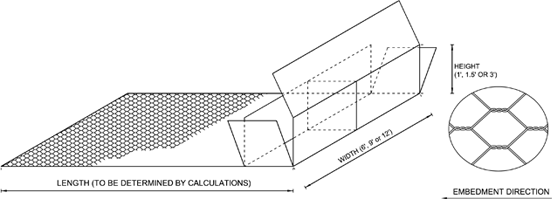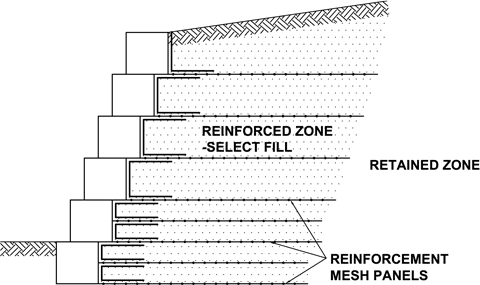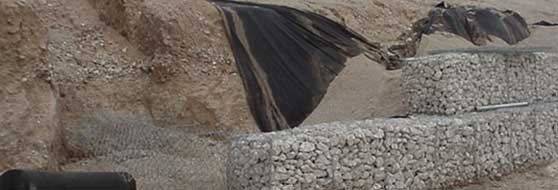Stable Slope System (MSE Walls)


The Terra Aqua Stable Slope System is a mechanically reinforced soil gabion wall fabricated from a continuous double twisted PVC coated wire mesh that makes up the gabion basket facing and the mesh reinforcement panel. Terra Aqua’s monolithic design of the Stable Slope System allows the mesh reinforcement and the gabion wall face to offer porosity, strength, durability, and flexibility. Each unit should be placed in the direction of maximum strength, which is the direction the mesh is woven, lying parallel to the direction of soil stress.
Common Applications: Typically Fill-Type Situations
- Retaining Walls
- Stream Bank Protection
- Slope Reinforcement
- Slope Stabilization
- Slide Repair
- Headwalls & Wing Walls


Advantages of the Terra Aqua Stable Slope System



- Terra Aqua’s Stable Slope units utilize the double twisted hexagonal gabion mesh to provide the reinforcement in the horizontal plane. The double twisted hexagonal mesh offers friction on the surface of the PVC coated wire combined with the mechanical interlocking properties of the backfill material. This is due to the large mesh opening dimension in relation to the diameter of the PVC coated wire, and results in an increase in the total strength of the reinforcement which would not be possible for materials whose strength is derived from surface friction only and does not allow the backfill material to interlock through the mesh itself.
- The Terra Aqua Stable Slope System requires minimal foundation preparation. Typically, if the bearing capacity of the founding soil is adequate, the Stable Slope System can be placed directly on graded soil – unlike modular concrete block walls which generally require a concrete foundation.
- The Terra Aqua Stable Slope System requires no additional drainage provisions to relieve hydrostatic pressure behind the gabion wall facing. The gabion wall facing filled with 4”-8” durable stone will provide a porosity of 25%-30%.
- The monolithic configuration of the Terra Aqua Stable Slope unit eliminates concern for a minimal strength requirement for the geogrid reinforcement to wall face connection (such as that which exists for geogrid modular block walls).
- Unique to the Stable Slope System, there is a strong similarity in the geotechnical properties between the stone fill of the gabion facing and the compacted granular backfill material in the reinforced zone. The stress in the compacted granular backfill material in the reinforced zone and the facing stone in the gabion is distributed equally into the wire reinforcement in both. The result of this is that both materials subject the wire mesh to the same strain rate.


- The Terra Aqua Stable Slope System can easily be vegetated or bioengineered for vegetation growth. This is a key factor for stream bank restoration applications and other environmentally sensitive installations.
- The Terra Aqua Stable Slope System does not burn in the event of a fire. Unlike goesynthetic materials such a geogrids and geotextile filter fabric, the Terra Aqua double twisted mesh is made from steel and is not flammable.
Structural Backfill (in the Reinforced Zone)
Structural compacted backfill placed in the reinforced zone should consist of clean, washed, graded crushed stone coarse angular aggregate a maximum of 1 ½ inches in size, or a low PI “select fill.” Select fill should consist of uniformly blended clayey sand with a PI between 4 and 15, a Liquid Limit of 40 or less, and between 20 and 45 percent passing a No. 200 sieve. Select fill should be placed in maximum loose lifts of 8 inches, and should be compacted to a minimum of 95 percent of the Standard Proctor density at a moisture content between -2 and +3 percent of optimum.
A minimum internal angle of friction of 36 degrees can be obtained in compacted angular crushed stone fill, and a minimum internal angle of friction of between 28 and 30 degrees can be obtained in compacted select fill material.


Tensile Strength and Anchorage Capacity of Double Twisted Hexagonal Mesh
The maximum tensile load obtained by the mesh in direct laboratory tensile testing is 2,900 lb/ft of mesh panel. The pullout coefficient for a double twist mesh reinforcement in fine sand = Cs = 0.91. This means that the design anchorage capacity for the mesh panel confined in fine sand is equal to 3,160 lb/ft (3,160 lf/ft x 0.91 = 2,900 lb/ft). Design anchorage capacity for the mesh panel confined in compacted soil in which the mesh is subjected to slight damage during installation is equal to 3,160 lb/ft / 1.24 safety factor = 2,540 lb/ft.


